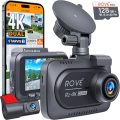When you’re stranded on the side of the road with a dead battery, the frustration can be overwhelming. Whether you’re rushing to an important appointment or trying to get home after a long day, the last thing you need is the added stress of a car that won’t start. That’s where a portable car battery charger comes in—a convenient and lifesaving tool that can get you back on the road in no time. In this blog post, we’ll walk you through the key factors to consider when choosing the right portable car battery charger for your needs. By understanding what to look for, you can ensure that you’re prepared for any unexpected battery issues that may arise. Let’s dive in and empower you to make an informed decision!



Understanding Battery Types
When it comes to portable car chargers, understanding the different types of car batteries is essential for ensuring compatibility and optimal performance. Each battery type has distinct characteristics that influence how it interacts with chargers. In this section, we’ll explore the three main types of car batteries—lead-acid, Absorbent Glass Mat (AGM), and gel batteries—and how they impact the choice of a portable charger.
Lead-Acid Batteries
Overview
Lead-acid batteries are the most common type of car battery, widely used in conventional vehicles. They consist of lead plates and sulfuric acid, which generate electricity through chemical reactions. While they are affordable and reliable, they have limitations in terms of weight, lifespan, and power output.
Characteristics
- Weight: Generally heavier than other battery types.
- Lifespan: Typical life expectancy is 3 to 5 years.
- Power Output: Excellent for high-current applications like starting engines.
Recommended Chargers
Portable chargers suitable for lead-acid batteries often feature a high-current output. For example, the NOCO Genius G3500 is a versatile charger compatible with lead-acid batteries, providing up to 3.5 amps of charging power.
Important Points
- Ensure the charger has a compatible charging profile for lead-acid batteries.
- Avoid overcharging, as it can lead to damage and reduced lifespan.
AGM Batteries
Overview
Absorbent Glass Mat (AGM) batteries are a type of lead-acid battery but designed with a fiberglass mat that absorbs the electrolyte. This design makes AGM batteries spill-proof, more resistant to vibration, and capable of deeper discharges compared to traditional lead-acid batteries.
Characteristics
- Weight: Typically lighter than standard lead-acid batteries.
- Lifespan: Can last 4 to 7 years with proper maintenance.
- Power Output: High performance and can handle multiple deep-cycle discharges.
Recommended Chargers
For AGM batteries, a smart charger is ideal. The Schumacher SC1281 is an excellent choice, featuring a microprocessor that adjusts the charge type and speed based on the battery’s condition.
Important Points
- Look for chargers with settings specifically for AGM batteries.
- AGM batteries can be charged faster, but overcharging may cause damage.
Gel Batteries
Overview
Gel batteries utilize a silica-based gel electrolyte, which makes them distinct from traditional lead-acid and AGM batteries. They are less susceptible to temperature extremes and are often used in applications where safety and spill prevention are paramount.
Characteristics
- Weight: Similar weight to AGM batteries.
- Lifespan: Lifespan can reach 5 to 7 years with proper care.
- Power Output: They deliver stable power over a longer time, making them suitable for deep-cycle applications.
Recommended Chargers
For gel batteries, a charger with a dedicated gel mode is crucial. The CTEK MXS 5.0 is a notable choice, featuring a program specifically designed for gel batteries, ensuring optimal charging without overdoing it.
Important Points
- Always use a charger that explicitly states compatibility with gel batteries.
- Gel batteries are sensitive to charging voltage; excessive voltage can lead to gassing and damage.
Compatibility Between Charger and Battery Type
Understanding the compatibility between your portable charger and the type of battery you have is vital for both safety and performance. Here are some key considerations:
- Charging Profile: Each battery type requires a specific charging profile. Chargers like the NOCO Genius and Schumacher SC1281 are designed to accommodate multiple types, making them versatile options.
- Voltage Settings: Ensure the charger matches the voltage of your battery (usually 12V for most car batteries).
- Smart Charging Features: Look for chargers with smart technology that can automatically detect battery type and adjust the charging process accordingly.
Comparison Table of Battery Types and Charger Recommendations
| Battery Type | Characteristics | Recommended Charger | Key Features |
|---|---|---|---|
| Lead-Acid | Heavy, 3-5 years lifespan | NOCO Genius G3500 | Versatile, 3.5 amps, compatible with lead-acid |
| AGM | Lightweight, 4-7 years lifespan | Schumacher SC1281 | Microprocessor-controlled, AGM settings |
| Gel | Stable power, 5-7 years lifespan | CTEK MXS 5.0 | Dedicated gel mode, prevents overcharging |
By understanding these battery types and their implications for charger selection, you can make an informed decision that will enhance the longevity and performance of your vehicle’s battery system.



Key Features to Look For
When selecting a portable car battery charger, it is essential to consider various features that can influence its performance and usability. Below are some key aspects to evaluate, including power output, size and weight, safety features, and additional functionalities.
Power Output (Amp Rating)
The power output of a portable car battery charger is a critical feature that determines how quickly and effectively it can jump-start a vehicle. The amp rating usually ranges from 200 to 1000 amps, and higher ratings mean the charger can jump-start larger engines more efficiently.
Examples of Amp Ratings:
- NOCO Boost Plus GB40: This portable charger provides 1000 amps, making it suitable for multiple vehicle types, including cars, trucks, and motorcycles.
- DBPOWER 800A: This model offers 800 amps, allowing it to jump-start vehicles with up to a 7.2L gas engine or a 5.5L diesel engine.
Considerations:
- Type of Vehicle: If you primarily own smaller cars, a lower amp rating may suffice. However, for larger vehicles or frequent users, opt for a higher amp rating.
- Cold Weather Performance: Ensure the charger can perform well in cold conditions, as battery performance can diminish in low temperatures.
Size and Weight
Portability is one of the main advantages of a car battery charger. The size and weight of the charger play a significant role in how easily you can store and transport it.
Lightweight Options:
- TACKLIFE T6: Weighing only 1.3 pounds, this compact device is easy to carry in your glove compartment or backpack.
- GooLoo 1200A: Despite its higher power output, this charger remains relatively lightweight, making it a practical choice for travel.
Considerations:
- Storage Space: Always consider where you will store the charger in your vehicle. Ensure it can fit comfortably without taking up too much space.
- Ease of Use: A heavier charger may be more cumbersome to handle, so lighter options can often be more user-friendly.
Safety Features
Safety is paramount when dealing with battery chargers, as improper use can lead to damage or accidents. Look for chargers equipped with essential safety features.
Key Safety Features:
- Reverse Polarity Protection: Prevents damage to the charger and battery if the clamps are connected incorrectly.
- Overload Protection: This feature automatically shuts off the charger if it detects overheating or an overload situation.
- Spark-Proof Technology: Ensures that there are no sparks when connecting the clamps, reducing the risk of fire.
Examples of Safe Choices:
- Schumacher DSR ProSeries 1200A: This model boasts multiple safety features, including reverse polarity and overload protection.
- Stanley J5C09: Known for its robust safety measures, this charger provides protection against sparks and reverse polarity connections.
Additional Functionalities
The best portable car battery chargers often come with extra features that enhance their usability beyond just jump-starting a vehicle.
Useful Add-Ons:
- USB Ports: Many modern chargers include USB ports, allowing you to charge devices like smartphones and tablets.
- NOCO Boost HD GB70: Features a 2.1A USB output, making it convenient for charging portable electronics on the go.
- Built-in Flashlight: Some models have built-in LED flashlights for emergencies.
- RAVPower 800A: Comes with a bright flashlight and SOS mode, making it handy during night-time emergencies.
Comparison Table of Key Features
| Model | Power Output (Amps) | Weight (lbs) | USB Ports | Safety Features |
|---|---|---|---|---|
| NOCO Boost Plus GB40 | 1000 | 2.4 | Yes | Reverse Polarity, Overload |
| DBPOWER 800A | 800 | 1.5 | Yes | Reverse Polarity |
| Schumacher DSR ProSeries | 1200 | 3.5 | No | Reverse Polarity, Overload |
| Stanley J5C09 | 1000 | 5.5 | Yes | Reverse Polarity |
| TACKLIFE T6 | 600 | 1.3 | No | Reverse Polarity |
| RAVPower 800A | 800 | 2.0 | Yes | Reverse Polarity |
By evaluating these key features and comparing various models, you can make an informed decision when purchasing a portable car battery charger that meets your needs and expectations.



Key Takeaways for Smart Charging Choices
In conclusion, selecting the right portable car battery charger requires a thorough understanding of the different battery types, essential features, and reliable brands available on the market. By evaluating your specific needs—such as the size of your vehicle’s battery, the charger’s power output, and additional functionalities like safety features or portability—you can make an informed decision. Investing time in this assessment ensures that you choose a charger that not only meets your requirements but also provides peace of mind during unexpected battery failures. Remember, a quality portable car battery charger can be a lifesaver on the road, so choose wisely.






Just wanted to share – I used a portable charger from Ansmann last winter and it saved me from being stranded! Total lifesaver!
Awesome to hear that! It’s always great to know a product did its job. Thanks for sharing your success story!
Thanks for your suggestion! We’ll definitely consider writing about battery maintenance in the future. It’s super important for keeping those chargers handy!
I’ve heard some debates about the effectiveness of lithium-ion vs. lead-acid chargers. Can you dig deeper into that?
That’s a great point! We’ll look into doing a comparison of lithium-ion and lead-acid chargers in a future post. Stay tuned!
Can you give more info on the specific features of the NOCO Genius G3500? I’ve been eyeing it but still unsure!
Absolutely! The NOCO Genius G3500 is fantastic! It has advanced features like an easy-to-read display and safety protections. We’ll add more details in the next article!
Hey, great article! I’d love to see a piece on how to maintain your car battery to extend its life. Any tips?